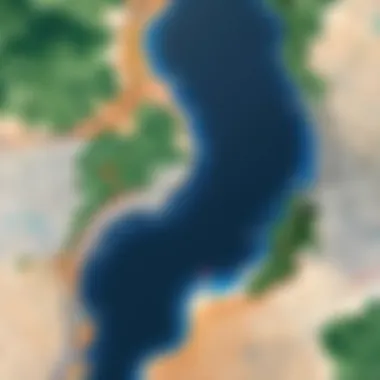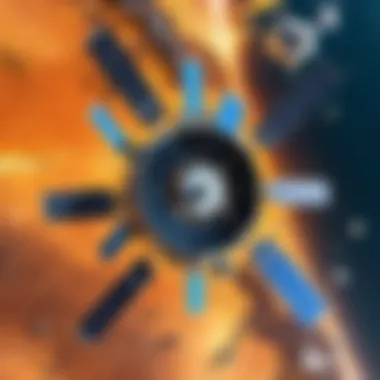Exploring Google Earth's Real-Time Viewing Technologies


Intro
The advent of satellite technology has transformed how we view the world, allowing users to explore geographic data from their devices. This article investigates the capabilities of Google Earth in real time, aiming to clear misconceptions and explain the relevant technologies. Understanding the intricate levels of satellite imagery and the practical options for viewing are crucial in this context. A key component will be to highlight how different mapping services work to provide their users varying levels of detail.
Overview of the Technology
Google Earth operates primarily through a combination of satellite imagery, aerial photography, and GIS (Geographic Information Systems) data. The platform allows users to zoom in on any location on Earth and observe geographical features with a compelling detail.
Key Specifications
Google Earth utilizes high-resolution satellite images that are collated frequently. However, the frequency of updates varies depending on the geographical area. Urban areas receive updates more often than remote regions. The platform offers:
- 3D building models for many cities.
- Street view options to provide ground-level perspectives.
- Historical imagery to compare geographical changes over time.
Unique Selling Points
One of the defining features of Google Earth is its accessibility. Unlike many other mapping services, it offers users the ability to fly over locations in a visually engaging manner. Additionally, the integration of different geographic information systems sets Google Earth apart, providing layers of information that can include terrain, time stamps for historical data, and even climate data.
Limitations of Real-Time Viewing
Despite its impressive capabilities, Google Earth does not support real-time satellite imagery. The images displayed can be days, weeks, or even months old, depending on the location. This limitation stems from the inherent nature of satellite imagery collection and processing. The necessary technology to facilitate true real-time viewing is still evolving.
This is important to recognize, as many users automatically assume that they are accessing current data. The reality is different, and it is essential for users to understand these parameters when utilizing the platform.
"Real-time viewing is not yet feasible with current satellite technology due to logistical and operational limitations, despite the advanced capabilities of services like Google Earth."
Exploring Alternatives
While Google Earth might not provide real-time data, there are alternatives that offer users near-real-time updates. Specific services such as NASA Worldview and Sentinels can give insights into weather conditions and environmental changes almost instantaneously. These sources gather data from a variety of satellite sensor systems utilising close to real-time updates.
Future Prospects
Technology in satellite imagery continues to advance rapidly. With the ongoing development of new satellite systems, the dream of real-time viewing is becoming more plausible. Innovations in artificial intelligence and machine learning may also enhance the processing time of satellite images, further bridging the gap between expectation and reality.
Preamble to Google Earth
In today's digital landscape, Google Earth serves as a pivotal tool for users interested in geography, education, and mapping technologies. Its importance is rooted in the unique ability it provides to explore the planet in a detailed manner. The platform combines complex satellite imagery with user-friendly interfaces, making geographical exploration accessible to both experts and casual users. Understanding Google Earth is essential as it sets the foundation for the discussion of its real-time viewing capabilities.
Overview of Google Earth
Google Earth is an interactive globe that allows users to view a 3D representation of Earth using satellite imagery. It provides highly detailed views, from entire countries down to individual streets. Users can explore various layers of information, such as terrain, borders, and even historical imagery. The program is more than just a mapping service; it acts as a virtual window to the world, giving insights into geography, culture, and environment.
Some key features of Google Earth include:
- Comprehensive Satellite Imagery: Users can access high-resolution images that showcase landscapes, architecture, and natural wonders.
- User-Generated Content: Individuals can add their own locations and information, enriching the data available.
- Educational Resources: The platform provides tools and features that are useful for educators and students.
Through its diverse capabilities, Google Earth empowers users to engage with their environment like never before.
Historical Development of Google Earth
The evolution of Google Earth is a compelling story of technological progression. Originally developed by Keyhole, Inc., the software was released in 2001. Google acquired the company in 2004, integrating its technology into its vast ecosystem. The initial launch was groundbreaking, offering the first consumer-friendly software capable of displaying 3D satellite images.
Over the years, Google Earth has seen numerous updates and enhancements, including:
- Improved Imagery: The quality and frequency of updates have significantly increased, allowing for more precise pictures of our planet.
- Integration of Additional Data Layers: Google Earth has expanded to include weather data, historical imagery, and even user-contributed data.
- Adoption of Mobile Platforms: With the introduction of mobile apps, Google Earth has become widely accessible, reaching a larger audience.
Overall, the historical development of Google Earth reflects shifts in technology and user expectations, positioning it as an essential tool for real-time geographical exploration.


Defining Real-Time Viewing
The exploration of real-time viewing capabilities introduces a crucial foundation for understanding the current landscape of digital mapping technologies. Real-time viewing signifies the potential to access and view geographical data that reflects changes as they occur, providing the user with an experience that can feel immediate and immersive. This capability holds great value for various applications, including disaster response, environmental monitoring, and urban planning.
Real-time viewing allows for timely decision-making and situational awareness. Users such as government agencies, research organizations, and corporations can benefit from this immediacy. As we examine the importance of real-time viewing, several elements become apparent: the speed of data acquisition, the integration of new technologies, and the implications for privacy and safety.
Understanding these factors helps clarify the relevance of real-time viewing in applications which require up-to-date data. However, realizing this potential requires technological advancement and thoughtful consideration of challenges as well.
What Does Real-Time Mean?
Real-time, in the context of mapping and geographic data, refers to the ability of systems to acquire, process, and deliver updates almost instantaneously. This immediately available information can stem from various sources including satellites, sensors, and aerial imagery. For instance, satellite imagery can provide updated views of specific areas because the data can be processed and transmitted quickly.
Users see real-time capabilities through interfaces that display live data feeds. This may involve live traffic conditions, weather patterns, or emergency alerts. This immediacy supports the user's need to analyze and respond to changing environments effectively. While the idea of real-time often suggests a seamless experience, the reality is that there are inherent complexities in achieving true real-time visualization due to factors like latency and processing speed.
"Real-time data can create a pivotal difference in how we manage crisis situations, enhancing our capacity to react and adapt quickly."
The Limitations of Real-Time Mapping
While the vision of real-time mapping may appear appealing, it is essential to highlight the limitations that exist within this domain. First and foremost, the frequency of satellite passes and processing delays contribute significantly to the availability of fresh data. For example, commercial satellites like those from Planet Labs may revisit the same area daily, but this is not itself true real-time. Instead, it paints a picture that is updated but still not instantaneous.
Other limitations include:
- Technical Constraints: Accessing real-time data often requires high-level technological infrastructure that may be unavailable to all users.
- Data Quality: The reliance on live feeds raises concerns about accuracy. In fast-changing situations, information may be incomplete or erroneous at times.
- Privacy and Security: Real-time capabilities raise questions about surveillance and privacy. Mapping services must navigate regulatory frameworks to maintain user trust while offering such features.
In summary, while the concept of real-time viewing in mapping services offers enticing possibilities, numerous elements and limitations must be addressed to make this concept a practical reality.
Current Capabilities of Google Earth
Understanding the current capabilities of Google Earth is crucial as it lays the groundwork for comprehending its real-time viewing potential. Google Earth combines vast amounts of satellite imagery with advanced technology to present an extensive view of the Earth’s surface. Users are able to explore various geographical regions, analyze terrain data, and even dive into historical layers of Earth’s imagery. This capacity is particularly relevant in applications such as urban planning, environmental monitoring, and disaster management. Knowing the capabilities helps in setting realistic expectations about real-time functionalities.
Satellite Imagery Update Frequency
The update frequency of satellite imagery in Google Earth is significant in determining the relevance of the data displayed to users. Google Earth primarily utilizes imagery from a variety of sources, including both commercial and government satellites. The temporal frequency of these updates can vary widely. For instance, some regions may receive updates as frequently as every few days, while others may only be updated once every few years. This inconsistency can lead to misconceptions about what is available in real-time as images can appear outdated.
In many cases, users will notice that the current view may not reflect recent changes, such as natural disasters or urban developments. Additionally, Google Earth provides an option for users to view historical imagery to observe changes over time. This feature is crucial for researchers and professionals who need to analyze geographical changes but it does not provide real-time insights.
Data Sources for Google Earth
Google Earth gathers its data from an array of sources, each contributing to the richness of its mapping capabilities. The primary sources include:
- NASA: Provides extensive satellite imagery and research data.
- US Geological Survey: Supplies topographical and land use information.
- Commercial Satellites, like those belonging to Maxar Technologies, which offer high-resolution imagery.
- User-uploaded Data: Allows the community to contribute data enhancing the overall utility.
This diversity of sources creates a mosaic of information that gives users a detailed experience. However, the challenge lies in ensuring the reliability and recency of the imagery. Users must understand that the freshness of data can vary greatly based on the source and location.
Viewing Changes Over Time
One of the most compelling features of Google Earth is its ability to allow users to view changes over time. By utilizing historical imagery, users can track evolution in urban landscapes, deforestation, or the effects of climate change over years. This temporal aspect empowers users to conduct research or gain insights that would otherwise be unavailable.
The time-lapse view is an essential tool for educators, environmentalists, and urban planners, offering visual evidence of transformations in physical land. While this feature effectively shows what has changed over time, it again emphasizes that real-time viewing remains limited. The focus is not on live data but rather a retrospective analysis that provides context and understanding about the Earth’s shifts.
"Historical imagery provides invaluable context for examining our planet's changes, although it still does not provide a real-time perspective."
In summary, the core capabilities of Google Earth, including its update frequency, data sources, and features for viewing changes, play a vital role in how users interact with the platform. They highlight both the strengths and the limitations of what Google Earth can offer in the context of real-time viewing.
Understanding Alternatives to Real-Time Viewing
Real-time viewing is a fascinating concept that attracts many technology enthusiasts. However, the limitations of existing technology have led to the emergence of alternative methods for geospatial viewing. These alternatives can provide users with useful insights while also proposing different perspectives on geographic data.


Focusing on alternatives helps to offer a more comprehensive understanding of what is available beyond real-time viewing. This understanding is vital in recognizing the capabilities of different platforms and technologies, as well as their respective strengths and weaknesses. The exploration of these alternatives can significantly enhance users’ mapping experiences and decisions.
Other Mapping Services
Comparative Analysis of Mapping Platforms
When analyzing various mapping services, it is essential to compare their key features and functionalities. Each platform can serve different user needs based on the specific requirements such as accuracy, update frequency, and visual presentation. A notable characteristic of mapping services like ArcGIS and OpenStreetMap is their emphasis on user-generated content and community collaboration.
These platforms, unlike Google Earth, often focus on a broader range of data types, including social, environmental, and economic information. Their open-source nature allows for constant updates and improvements, making them a strong choice for researchers and professionals alike. A unique feature of these platforms is the ability to contribute real-time data instantly, which can be seen as an advantage in situations requiring immediate information.
Strengths and Weaknesses of Competing Technologies
The competitive landscape of mapping technologies presents both strengths and weaknesses. Traditional satellite services such as Bing Maps or Here Maps have high-resolution imagery with solid satellite data. However, they might not always ensure the same level of detail as Google Earth.
One significant strength of these alternatives is their integration with local navigation apps like Waze and Google Maps. Such integration allows for real-time traffic updates and route planning, providing a comprehensive suite of tools for users. Yet, a drawback is frequently found in their lack of a captivating visualization experience compared to platforms designed like Google Earth, which offers a more immersive approach to geographic exploration.
Live Satellite Feeds
Accessing Live Feeds
Live satellite feeds serve as another avenue for obtaining real-time data. Accessing these feeds can enable users to view current weather conditions, natural disasters, or any other significant real-time events across the globe. Services such as NOAA and NASA offer opportunities for users to access live datasets, which can enhance decision-making processes in various fields, including environmental monitoring and urban planning.
However, accessing live feeds often comes with restrictions. These feeds may require specific subscriptions or institutional affiliations, which can limit user engagement. Ensuring user awareness of these limitations is crucial.
Applications of Live Satellite Data
The applications of live satellite data are diverse and impactful. They include environmental monitoring, disaster management, and agriculture. Organizations can utilize these data for effective risk assessments and timely responses. A prominent characteristic of live satellite data is its ability to offer timely insights, proving beneficial during emergencies.
Yet, there are inherent limitations as well. The providers may not always guarantee continuous access, causing occasional information gaps. Additionally, the data may be less user-friendly than historical database maps. This factor can deter casual users who may not be accustomed to interpreting complex datasets.
Understanding these alternatives not only broadens the scope of mapping solutions available but also empowers users to make informed choices aligned with their specific needs.
Technological Innovations Impacting Mapping
Technological innovations play a crucial role in shaping how we interact with mapping services like Google Earth. With rapid advancements in satellite technology and imaging techniques, the landscape of mapping has transformed significantly. Understanding these innovations is fundamental for grasping the current and future capabilities of real-time viewing systems. They not only enhance the quality of data available but also influence the user experience through better accessibility and features.
Advancements in Satellite Technology
Recent improvements in satellite technology directly contribute to the quality of satellite imagery used in services like Google Earth. New satellite designs, such as small satellites and nanosatellites, allow for a more flexible and cost-effective approach to satellite deployment.
One significant enhancement is the increase in the number of satellites in orbit. More satellites mean more coverage. This leads to more frequent updates of imagery. For instance, constellations like Planet Labs’ Doves operate numerous small satellites that can capture images of specific locations daily. This capability enables users to view changes to the landscape with remarkable frequency.
Moreover, advancements in sensor technology have improved the accuracy and resolution of the images captured. Modern satellites are equipped with high-resolution cameras and various sensors, capable of gathering data across different parts of the electromagnetic spectrum. This allows for more detailed and accurate mapping.
Imaging Techniques and Resolution
The techniques used for capturing images from space have evolved considerably, which affects the resolution of the imagery presented to users. High-resolution imagery is critical for applications requiring detailed analysis, such as urban planning and disaster monitoring.
Imaging techniques like Synthetic Aperture Radar (SAR) and multispectral imaging have gained traction.
- Synthetic Aperture Radar (SAR): This technique can acquire images regardless of weather conditions and daylight. It provides detailed information about the Earth's surface and helps identify changes in terrain or structures.
- Multispectral Imaging: This approach captures data at different wavelengths, providing rich information for various applications, including agriculture, ecology, and urban development.
The resolution of imagery varies between different satellites and imaging techniques. High-resolution images can be as detailed as 30 centimeters per pixel, allowing users to discern features like buildings and roads easily. This level of detail is essential for industries reliant on precise mapping, such as construction and environmental monitoring.
"Technology is not just about the tools; it is fundamentally about enhancing human understanding of the world around us."
Privacy Concerns with Real-Time Data


The topic of privacy concerns surrounding real-time data access is vital within the context of Google Earth. As the capabilities of satellite imagery expand, so does the potential for misuse of such technology. Users of Google Earth may not fully grasp the implications of sharing and viewing real-time data. This section dissects those implications, highlighting the ethical dimensions and the regulatory challenges that accompany advancements in mapping technologies.
Ethical Implications
The ethical implications of real-time viewing are multifaceted. The power of satellite imagery brings to light questions about personal privacy and consent. Individuals may not be aware that their movements and locations could be monitored without their knowledge. This raises pressing ethical concerns in various contexts, such as surveillance and data sharing among private companies and governments.
Furthermore, the capacity to view real-time imagery can inadvertently expose sensitive information. For example, if someone is able to track the movement of emergency services or law enforcement, there could be significant risks to public safety. The line between beneficial use of technology and invasion of privacy is extremely thin and can lead to serious ethical dilemmas.
Another consideration is the responsibility of tech companies. They must balance innovation with ethical standards. It is crucial for companies like Google to develop clear policies that govern the use of real-time data. Establishing stringent guidelines may help mitigate the risks associated with privacy violations. An informed user base could play a role in advocating for ethical use of real-time mapping tools.
Regulatory Challenges
The regulatory landscape governing real-time data access is complex and ever-evolving. As technology progresses, outdated legal frameworks struggle to keep pace. Existing privacy laws often do not adequately address the implications of real-time viewing. This is particularly true in jurisdictions where data protection lacks clarity.
The potential for misuse of real-time imagery presents a challenge for lawmakers. They must consider a variety of factors, including how to protect individual privacy rights while acknowledging the benefits of technology. Regulations such as the General Data Protection Regulation (GDPR) in Europe offer a framework for privacy protections. However, there are still gaps that need to be filled in the regulation of satellite imagery specifically.
Moreover, international cooperation is often necessary for effective regulation. Satellite data does not adhere to borders, making it difficult for singular nations to enforce privacy laws. Harmonizing laws across countries presents intricate challenges but is essential for protecting user privacy on a global scale.
In summary, the ethical implications and regulatory challenges related to real-time viewing capabilities are of utmost importance. Addressing these concerns is critical to ensure that technology serves the public good while respecting individual rights. With the rapid advancement of satellite technology, it becomes increasingly vital to engage in dialogue surrounding privacy and establish frameworks that mitigate risks associated with real-time data.
Future Prospects for Real-Time Viewing
The exploration of real-time viewing capabilities in Google Earth holds significant relevance for several reasons. Firstly, it opens up new possibilities for how we interact with geographic information. The expectations from modern mapping technologies are rapidly evolving. Users increasingly desire real-time insights into their surroundings, particularly for applications like emergency response, urban planning, and environmental monitoring. Thus, the future prospects for real-time viewing can greatly enhance decision-making processes across various sectors.
New developments in satellite technology and data processing methods propel us into an era where real-time applications are not just desirable but increasingly feasible. These innovations may include enhanced satellite sensors, more frequent data updates, and improved algorithms for data analysis. Consideration of how these advancements can integrate into existing platforms like Google Earth is crucial.
As modeling environments grow in sophistication, the integration of real-time data sources could lead to more informed planning and quick responses to dynamic situations, such as natural disasters or urban expansion. Future enhancements in user interface design will also likely allow users to engage with real-time data more intuitively.
For example, with the integration of Artificial Intelligence, mapping services may refine how users visualize and interpret real-time changes on the globe. This could potentially lead to a shift in focus toward personalized user experiences, where users can tailor data feeds relevant to their needs.
"Emerging technologies could redefine our interactions with geographic data, making the once limited realm of satellite imagery more accessible and dynamic."
Emerging Technologies on the Horizon
Emerging technologies present a myriad of possibilities for real-time viewing in Google Earth. One notable advancement is the enhancement of satellite imaging capabilities. For instance, small satellite constellations like Planet Labs can capture high-resolution images of Earth every day. These technologies aim to provide near real-time updates about specific areas, enabling sectors ranging from agriculture to security.
Other advancements include the following:
- Improvements in drone technology: Drones have become more affordable and versatile. They can capture aerial imagery and provide real-time data in environments where satellites may have limitations.
- 5G connectivity: The rollout of 5G networks enables rapid data transmission. This means that even as information is gathered, it can be processed and shared almost instantaneously.
- Geospatial AI: Artificial intelligence models can analyze geographical data patterns, benefiting applications from urban planning to disaster response.
Each of these technologies conjoin to create a foundation where real-time data viewing evolves from a concept to a practical application.
Predictions for Google Earth's Evolution
As technology advances, Google Earth is poised for substantial evolution. Future updates may prioritize a more interactive user experience. Users could manipulate layers of data in real-time, exploring dynamic changes as they unfold.
Moreover, Google Earth might incorporate enhanced functionalities such as:
- User-generated content: Allowing users to contribute real-time data could provide localized insights for particular regions.
- Greater integration with other platforms: Collaboration with social media and IoT devices could provide diverse data sources. For example, public safety data from social platforms and real-time environmental monitoring from IoT sensors may offer a comprehensive view.
- Virtual and Augmented Reality: These technologies can create immersive experiences, allowing users to engage with geographic data in innovative ways. Imagine moving through a real-time model of a city that reflects current traffic and weather conditions.
Ending
In examining real-time viewing capabilities within Google Earth, it becomes clear that this topic holds significant relevance. The potential to harness real-time data can offer new dimensions to how we interact with geographic information. For tech-savvy individuals and early adopters, understanding these capabilities expands their knowledge of technology's current limitations and advancements. As Google Earth continues to evolve, keeping an eye on these innovations is vital for anyone keen on emerging technologies.
Summary of Key Points
In summary, this article delves into several key aspects of Google Earth's real-time viewing features:
- Definition and scope of real-time viewing: Clarifying what real-time means within the context of mapping and its implications.
- Current capabilities: Evaluating how often satellite imagery is updated and the data sources available.
- Alternatives to real-time mapping: Discussing other services and technologies that offer various forms of real-time data.
- Future prospects: Highlighting potential advancements in technology that could revolutionize how we view and interact with maps.
Closing Thoughts on Mapping Technologies
As we look toward the future of mapping technologies, it is evident that developments in satellite technology and imaging will play a crucial role. The tension between privacy concerns and technological advancements presents a complex picture for developers and users alike. In considering these aspects, it is important to remain mindful of ethical debates surrounding data usage. Real-time viewing capabilities will likely continue to evolve, driven by both user demand and technological feasibility. Keeping up with these changes is necessary for anyone passionate about geography and technology.







